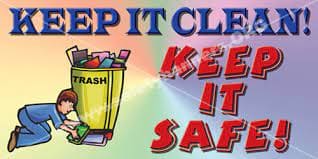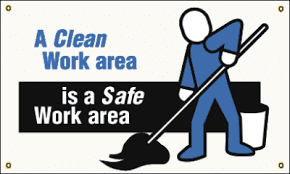Housekeeping in Safety go hand-in-hand
Housekeeping in Safety go hand-in-hand.
Good hosekeeping is not only about keeping a clean job site, it lays te foundation for accident and fire prevention.the key is removing hazards, so yu don't have to work around them.
Poor husekeeping can cause accidents such as tripping over loose objects on floors ,stairs and platforms being hit by falling objects not properly stored slipping on greasy, wet or dirty surfaces hitting protruding objects, poorly stacked items or misplaced material. cutting puncturing or tearing the skin of hands or other parts of the body on projecting nails, wire or steel strapping to mainatin a safe job site.

Hosekeeping should be done regularly throughout the ship and before you begain the job. make plans for adequate disposal of waste and materail.
Make sure work areas are sufficiently illuminate, clear and litter free, place waste containers and dumpsters in convernient locations, don't let trash pile up. so pick up things like boxes, scrap lumber,and other debris and properly dispose of them in a dumpster or other suitable container to prevent fire and trippng hazards.also keep all walkways and stairways throughout the jobsite free of materails such as tools, hoses, power cords and supplies to prevent tripping, always be on the lookout for protruding nails form lumber.and make sure you remove or hammer the nails flush with the lumber to eliminate exposure to puncturing or laceration injuries, spills should be cleared up as soon as possible especially if there is a chance for someone to slip or if the liquid itself is harzardous. store tools and materials where they are easily accessible, even some back strains can be prevented if equipment supplies or tools are easy to reach finally only eat and drink in designated areas on the jobsite fires are another hazard that can be prevented with good housekeeping pratices.catastrophic fires can occur on residential construction job sites, because employees are often working with mumerous flammable combustible materials. during hot work such as welding and using temporary heating devices, fires can result in serious damage to property,injuries and even death.
Make sure you know your company's fire production plan which includes the location of fire extinguishers, steps to warm others and notifying the fire department. ensure the evacuation routes, exits, fire extinguishers first aid stations and electrial panels are all easily accessible. It's important to be aware of potential fuel and ignition sources on the job site and follow established safety practices, so you and others are protected while working flammable or explosive materials should be properly stored and clearly marked containers with lids and separated from other materials, keep flammable materials away from heat sources, such as blow torches or space heaters.

Do not store flammable or explosive materials on stairways or exits and never store liquid propane gas inside buildings, gasonline and ther flammable liquids must be stored in safety cans outside or in an approved storage facilities never smoke near flammable materials or in the area where it's stored, somking is typically prohibited on all construction sites additionally avoid spraying paint and using solvents or other flammable materials in rooms with poor ventilation the build up of fuels and vapors can cause a fire or explosion with an ignition source present. when using temporary heaters follow the manufacturers manual and make sure they are on a stable, level surface in a well-ventilated space keep them away from walls and other flammable materials, like paper, wood or other scrap. before you begin hot work, such as welding, cutting, brazing,grinding protect the immovable fire hazards take steps to confine the heat, Sparks and flat. keep a fire watch in the work area for at least 30 minutes after completion of the hot work to make sure there's no further fire hazard. fire extinguishers should be easy to see and be within reach fire extinguishers will typically be multi-purpose ABC that can put out most fires.
ABC stands for class A combustible material like wood,paper and cardboard. Class B is flammable and combustible liquids like gasoline, paint thinner and kerosene. Class C is an electrical fire. It's important to remember to only fight a fire that you have been trained to do so,an easy way to remember how to use a fire extinguisher is the PASS method, it spells out each step you should take to use the extinguisher, P equals pull the pin on the extinguisher,A equals aim at the base of the fire A equals squeeze the handle start shooting the extinguisher as you approach the fire, but always keep a safe distance away the last S stands for sweep while you're shooting the extinguisher. move it back and forth in a sweeping motion still aiming at the base, this ensures that you get good enough coverage of the area that's on fire, Even though you may take all of these precautions a fire may still occur in the event of a fire, alert and make sure all workers,exit the structure immediately and call 119. we're all responsible for jobsite safety good housekeeping and fire prevention gives homeowners customers and visitors a good impression of your jobsite and commitment to safety and quality workmanship.










